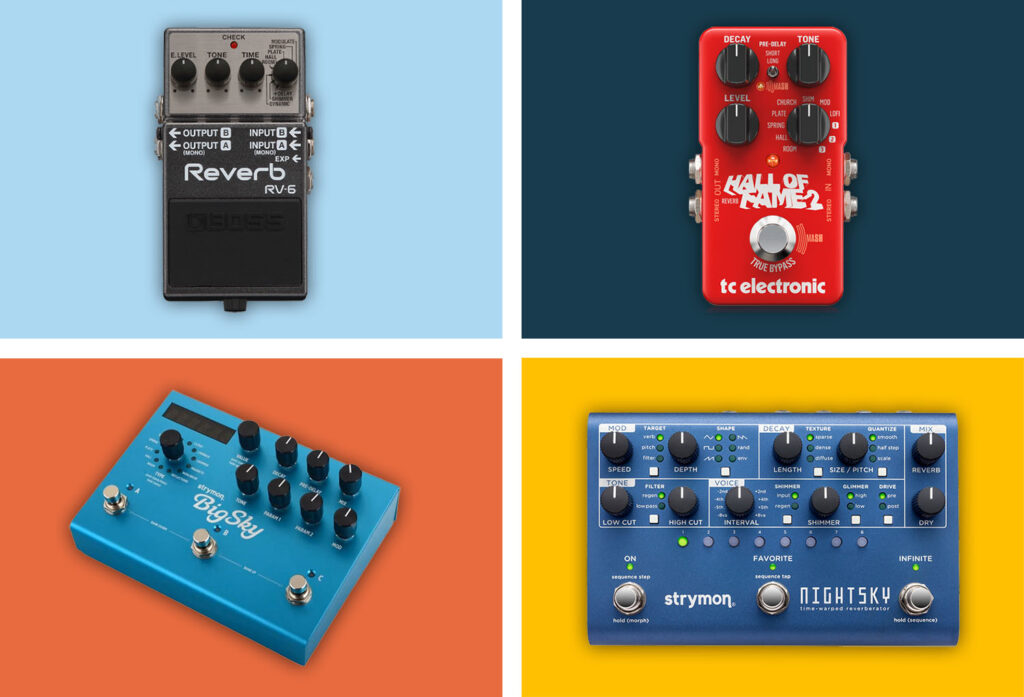The reverb pedal can simulate a variety of spaces, from small rooms to large halls, as well as metallic sounds such as spring or plate reverb. It adds depth and atmosphere to music by simulating the sound created when the sound waves from an instrument bounce off walls before reaching the listener. The reverb gives the impression that the instrument is far away.
An electric guitar sounds very dry and even a little unnatural without reverb, so almost all modern guitar amps have built-in reverb. Most amps have a spring reverb - a special type of reverb made with springs that sounds very metallic. This is actually quite good for electric guitars, but if you want a more natural reverb, such as a room reverb, you often have to resort to reverb pedals.
There are now well over 100 different electric guitar reverb pedals on the market, so it can be difficult to choose. We have put together this guide to help you make the right choice.
In a nutshell: Which reverb pedal is the best?
The best reverb pedal is the Strymon Big Sky because it sounds incredibly good and realistic, as Strymon develops some of the best reverb algorithms. The Boss RV-500 also sounds very good and realistic and also offers some vintage simulations that can be very useful.
If you are on a budget, the TC Electronic Hall of Fame 2 is the pedal with the best bang for your buck. The reverbs sound great, and you can add a lot of presets thanks to the TonePrint app.
Strymon Big Sky
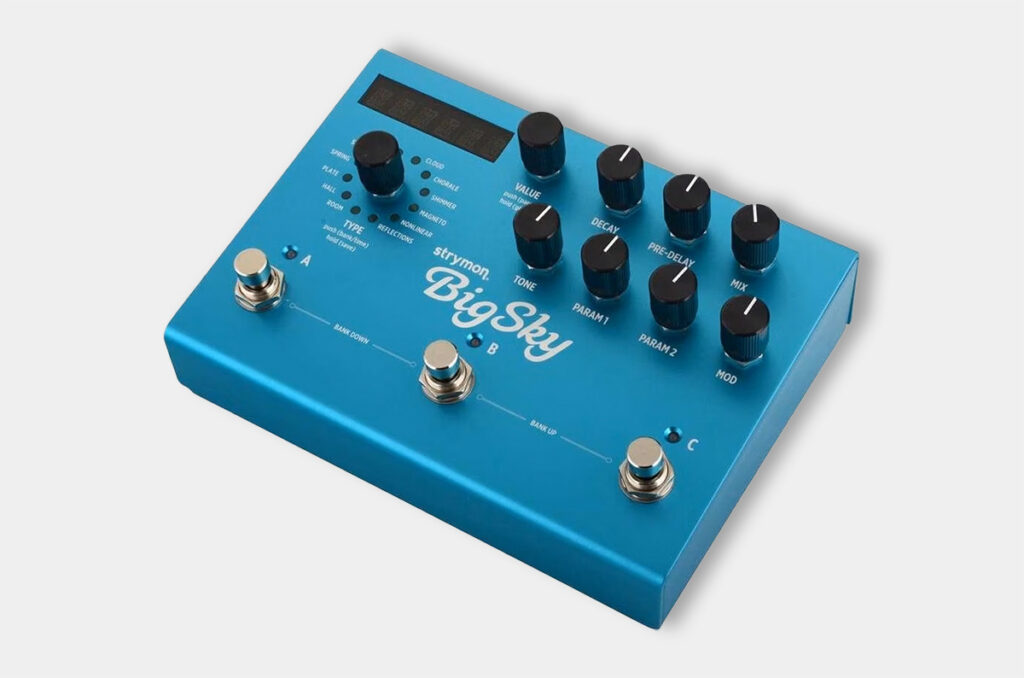
SPECIFICATIONS
Reverb types: 12
Parameters: Reverb type, value, decay, pre-delay, mix, tone, parameter 1+ 2 (different for each reverb type), modulation
Inputs/Outputs: Stereo input, stereo output, expression pedal, MIDI in/out
Bypass: True Bypass
Analog/digital: Digital
LINK
Strymon Big Sky (489€)
ARGUMENTS IN FAVOR
- Some of the best reverb algorithms available
- Reverb sounds very realistic
- Very extensive reverberation chamber design possible
- MIDI connection for DAW control
NEGATIVE POINTS
- Not cheap
First up in this comparison is the Strymon Big Sky, which in my opinion is the best reverb pedal ever made. It offers 12 different reverbs and all of them are of incredibly good studio quality. This pedal is great for both guitarists and producers because the reverb effects sound better than most plug-ins.
You can adjust all kinds of reverb parameters (decay, pre-delay, mix, tone, modulation, and more) to create spaces that are 100% your own. From natural rooms and large halls to metallic jump and plate reverbs, this reverb effect has it all.
The pedal even has a freeze function that sets the reverb time to infinite, so that the reverb never stops as long as the pedal is held down. This is great for adding dynamics to certain passages. When you take your foot off the pedal, the reverb stops immediately.
The pedal can store up to 300 presets, which should be more than enough for anyone. The device has MIDI inputs and outputs, so it can be perfectly connected to the DAW and the parameters can be controlled and automated via the DAW - a producer's dream!
Strymon is known for their incredible research into reverb algorithms, which has led them to develop the best reverb algorithms on the market. As a result, Strymon reverb pedals sound the best and most natural of all pedals - and that's not me saying this, it's a general consensus in the music world. I almost fell out of my chair when I first heard this pedal.
However, the price of just under 500 Euros is quite high - but in my opinion completely understandable. Reverb pedals are generally the most expensive effects of all because the reverb algorithms are so complex. And if you want the best of the best, you have to dig a little deeper.
TC Electronic Hall of Fame 2
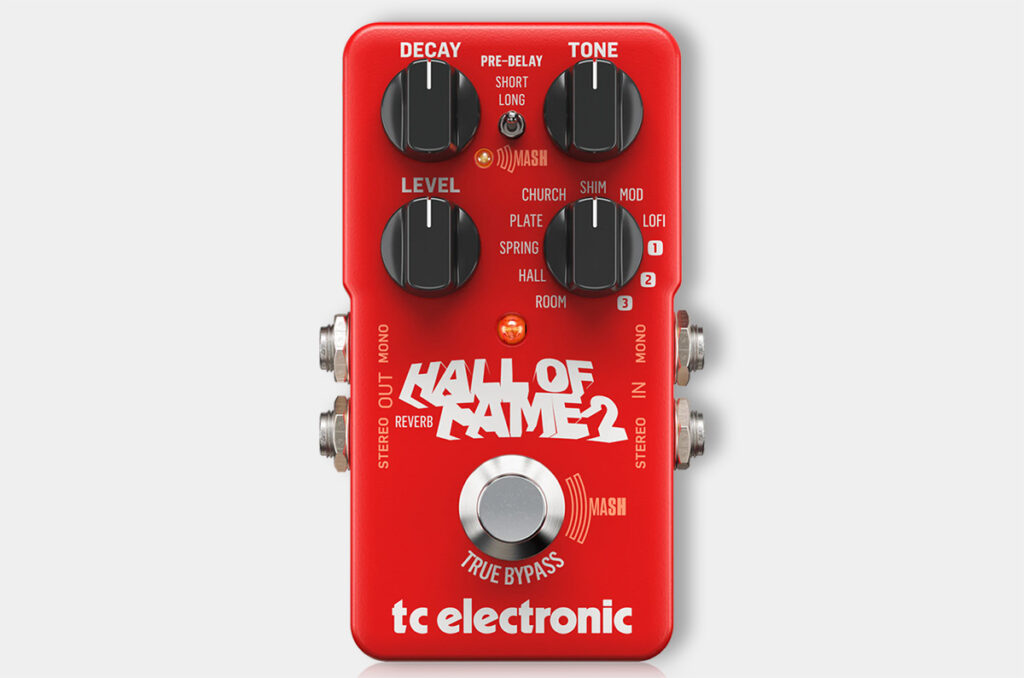
SPECIFICATIONS
Reverb types: 8 (+ 3 extensions via TonePrint)
Parameters: Reverb type, decay, tone, level,
Inputs/Outputs: Stereo input, stereo output
Bypass: True Bypass
Analog/digital: Digital
LINK
TC Electronic Hall of Fame 2 (155€)
ARGUMENTS IN FAVOR
- Great reverbs at a great price
- Many presets available through TonePrint
- Footswitch with Expression Controller Function
NEGATIVE POINTS
- –
When it comes to value for money, the TC Electronic Hall of Fame 2 is the clear winner. In addition to its 8 reverbs, this pedal also offers the ability to download and install external reverbs via the TonePrint app, or even create your own presets with far more parameters than are available on the pedal.
The TonePrint app contains a large number of presets created by TC Electronic in collaboration with renowned guitarists. These presets can then be easily installed via the mobile phone and used via the reverb mode control of the three free slots. The result is virtually endless sound design possibilities!
The reverb effects sound very good - not as natural as Strymon's, but perfectly adequate for guitarists. They range from subtle and barely perceptible to completely crazy reverbs with modulations that sound like you're playing the electric guitar in space.
One great feature is that the footswitch doubles as an expression controller. Thanks to MASH technology, the footswitch is pressure sensitive - so it works like an expression pedal, but instead of going up or down, you press harder or softer. For example, you can link the decay time to the controller and change it dynamically on the fly. If you press hard, the instrument sounds longer, if you press lightly, the decay time is very short.
With a retail price of only 155 Euros, this reverb pedal is a real bargain - I can recommend it without hesitation to any guitarist who doesn't want to dig too deep into their pockets. I myself have owned the first version of the pedal (TC Electronic Hall of Fame 1) since 2018 and am still thrilled with it.
Boss RV-500
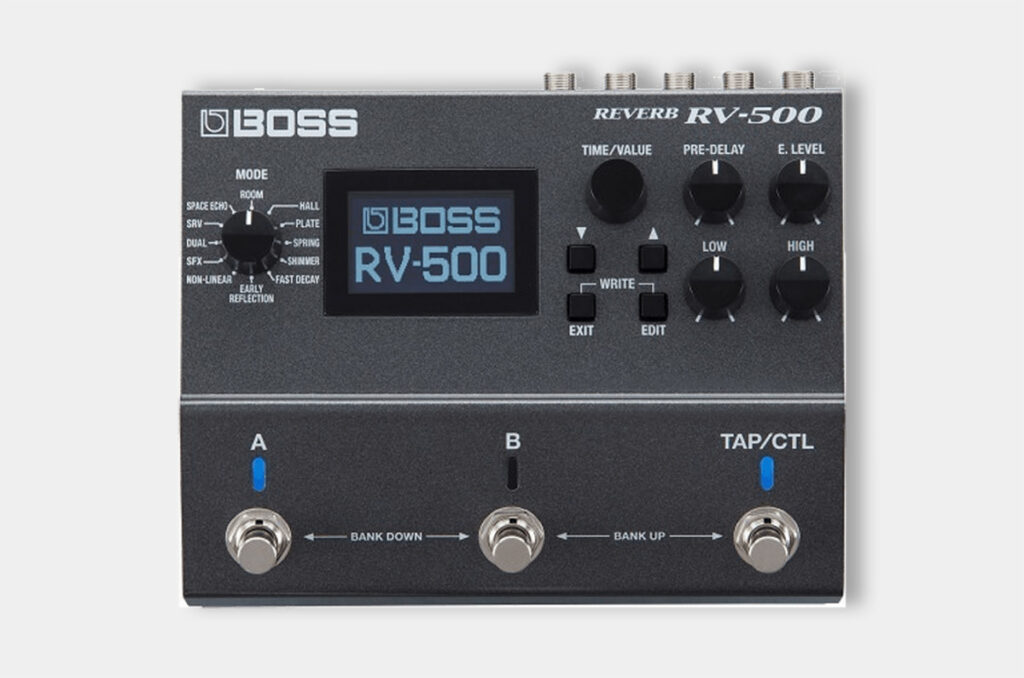
SPECIFICATIONS
Reverb types: 12
Parameters: Time value, pre-delay, effect level, low, high, further parameters available via combinations
Inputs/Outputs: Stereo input, stereo output, expression pedal, USB, MIDI in/out
Bypass: True Bypass
Analog/digital: Digital
LINK
Boss RV-500 Reverb (438€)
ARGUMENTS IN FAVOR
- 12 different reverb algorithms that all sound very realistic
- 297 preset memories
- Delay included
- True or buffered bypass selectable
NEGATIVE POINTS
- Handling can be a bit tricky, as not all parameters are directly available
This Boss reverb station is extremely powerful. Similar to the Stymon Timeline, the pedal offers 12 different reverb effects and 297 memory locations for your own presets. And all the reverbs sound incredibly good! In addition to the usual reverb types (Hall, Room, Plate), there are also simulations of classic Roland units such as the RE-201 Spache Echo.
This reverb unit allows you to combine two reverb effects for simultaneous use. You can either set both inputs and outputs to mono for two separate channels, each with its own reverb (for example, if you have two guitars connected to the unit and want to give each guitar its own reverb). It is also possible to assign both reverbs to one channel to create complex reverbs.
The unit offers a choice between true bypass and buffered bypass (buffered bypass is better when using long cables), a feature that few pedals offer. Another handy feature is the selectable carry-over function, which allows the reverb to continue sounding even after the unit is turned off or switched to a different preset.
Thanks to the powerful DSP processor, each reverb mode also has a switchable digital delay that sounds amazingly good!
The only downside is that setting up the reverb can be a little awkward at times, as many parameters are not physically available as knobs on the pedal, but have to be selected through various button combinations. But even that shouldn't be a problem with a little experience.
Fortunately, the unit has a USB port, so you can use the RV-500 Editor to create the reverbs on your computer/laptop, which of course makes your work a lot easier. With a retail price of €438, this reverb pedal is not cheap, but it also offers a lot of great features.
Universal Audio UAFX Golden Reverberator
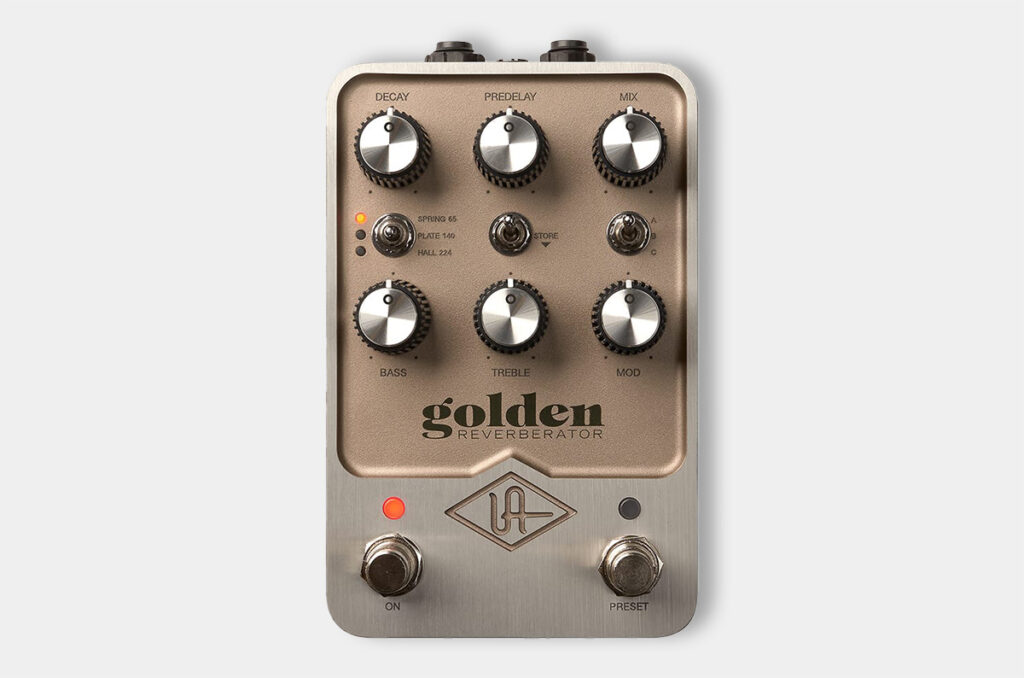
SPECIFICATIONS
Reverb types: 3
Parameters: Decay, pre-delay, mix, bass, treble, modulation, switch for selecting the reverb, A/B/C preset switch
Inputs/Outputs: Stereo input, stereo output, USB-C
Bypass: True or buffered bypass
Analog/digital: Digital
LINK
ARGUMENTS IN FAVOR
- Very realistic reproduction of 3 classic reverb devices
- Great sound
- Bass and treble control right at your fingertips
NEGATIVE POINTS
- The price is a bit high for only 3 reverbs
Universal Audio is known for producing some of the best digital emulations of classic audio hardware, and they have developed some of the best algorithms for creating these effects. The Universal Audio UAFX Golden Reverberator incorporates some of these algorithms and offers a total of 9 different reverbs.
These include a spring reverb that simulates the Fender spring reverb of a 1965 tube amp, a plate reverb from the 1950s, and a Lexicon 224 room reverb simulation. Each reverb has 3 different presets, for a total of 9 different presets. An additional 3 presets can be installed via the app.
The pedal offers many options for shaping the sound: In addition to the usual controls for decay time, pre-delay, and mix, there are bass and treble controls that can be used to boost or cut the highs and lows. Then there is the option to modulate the reverb.
I can recommend this pedal to anyone who particularly likes these 3 types of reverb. The pedal is not as versatile as others in this price range because it can only do these 3 types of reverb. But that makes it excellent - you won't find better emulations. So if you know these reverbs and like to work with them, there is no better pedal.
Boss RV-6
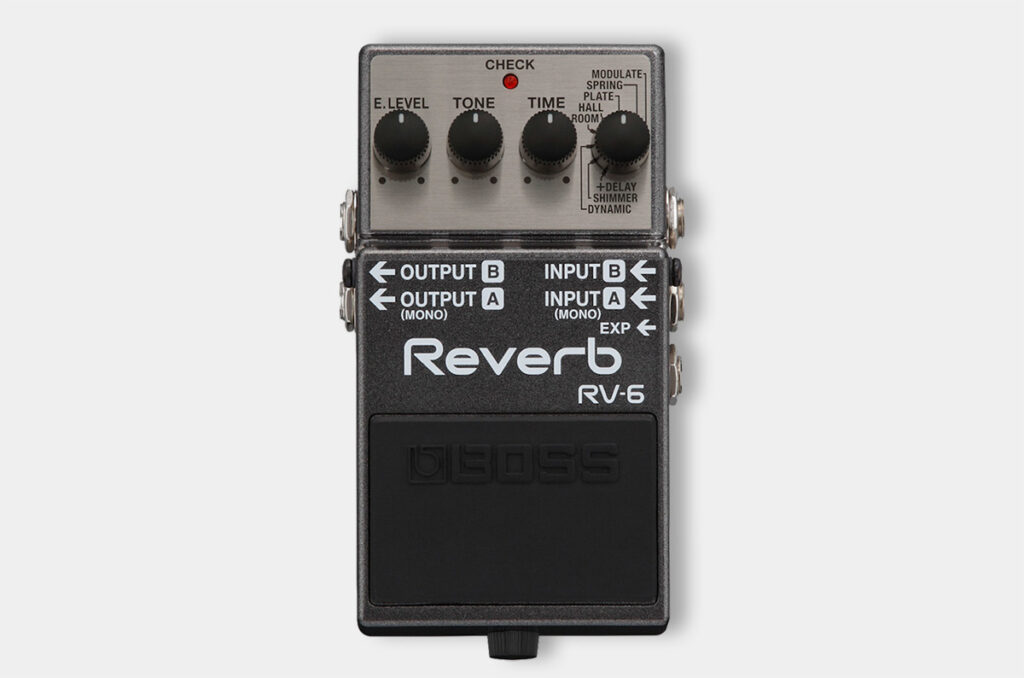
SPECIFICATIONS
Reverb types: 8
Parameters: Effect Level, Tone, Time
Inputs/Outputs: Stereo input, stereo output, expression pedal
Bypass: Buffered bypass
Analog/digital: Digital
LINK
Boss RV-6 (179€)
ARGUMENTS IN FAVOR
- Very good quality of the reverbs
- Compact and robust pedal
- Very good price
NEGATIVE POINTS
- Spring reverb sounds artificial
The Boss RV-6 is a great digital reverb in the classic small Boss format, which is small but packed with features. It offers a total of 8 different reverb modes, a mix control, a decay control, and a tone control (brighter/darker) - so you can create a lot of different sounds. I would even say that this pedal has the best bang for the buck.
All reverbs sound amazingly good and very realistic - only at extreme settings do they sound unnatural, but that is the case with all reverbs. A special feature is the Shimmer mode, which creates multiple voices in higher octaves and makes the reverb signal sound like a chorus. The Modulation mode adds movement to the sound, and the Dynamic Reverb mode reacts dynamically to playing (the higher the SPL, the louder the reverb).
An expression pedal can be connected to dynamically control the intensity/volume of the reverb as you play. Like all Boss pedals, this one is built to last for decades in the rehearsal room, on stage, and in the studio.
The only drawback is the spring reverb, which doesn't sound very good or realistic. However, this is often the case with digital emulations, which usually cannot reproduce spring reverb realistically. That's why there are analog spring reverb pedals that sound much better in this area.
For the amount of reverb and the quality of the reverb effects, the price of 179€ is a real bargain.
Eventide Space
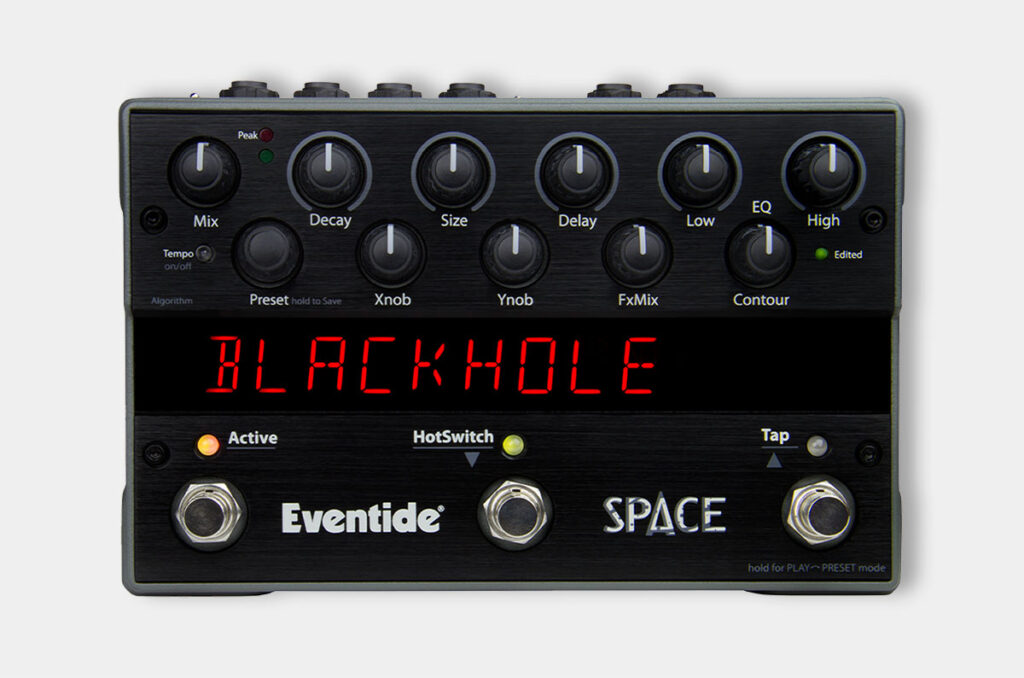
SPECIFICATIONS
Reverb types: 12
Parameters: Mix, Decay, Size, Delay, EQ Low, EQ High, Preset selector, FX-Mix, Contour, Xknob, Yknob
Inputs/Outputs: Stereo input, stereo output, expression pedal, aux switch, USB, MIDI in/out
Bypass: True Bypass
Analog/digital: Digital
LINK
Eventide Space (457€)
ARGUMENTS IN FAVOR
- Very versatile: many reverb types and extensive parameter control
- All parameters are at your fingertips
- 100 presets
NEGATIVE POINTS
- Not cheap
This Eventide reverb station leaves nothing to be desired: With a total of 12 different reverbs, 100 presets and 11 knobs, you can easily create the sound you want. It is very convenient that the knobs are physically present instead of having to be selected via menus - so you can see and move all the parameters directly.
And this reverb pedal has a lot of parameters: In addition to the standard Mix, Decay, and Delay parameters, there's a Size control that lets you increase or decrease the size of the simulated room, plate, or spring - very handy if you're working very precisely in the studio! There is also an equalizer with controls for treble, bass and, in some reverb modes, even mids!
I say sometimes because some knobs change their function depending on the reverb type. For example, the Contour knob controls the mids in Reverb mode, but controls the highs of the Cutoff EQ in Room mode. The Xnob, Ynob, and FXMix knobs behave similarly - their function changes depending on the mode. All functions are listed here.
The pedal works in stereo, has an expression pedal input for controlling all parameters via an expression pedal and a USB port for software updates on the computer. A great extra is the option to switch the input level between guitar and line level. Very practical if you want to use the pedal with synthesizers, as these normally work with line level.
Electro Harmonix Oceans 12 Reverb
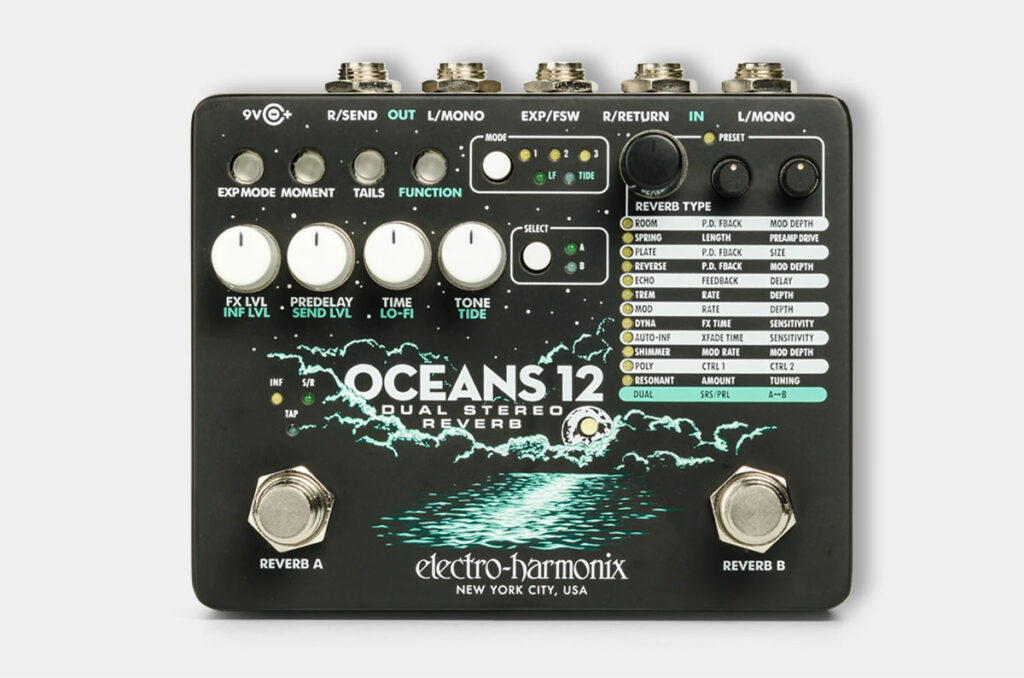
SPECIFICATIONS
Reverb types: 12
Parameters: FX Level/Infinite Level, Pre-Delay/Send Level, Time/Lo-Fi, Tone/Tide, Expression Mode, Moment, Tails, Mode Selector
Inputs/Outputs: Stereo input, stereo output, expression pedal/foot switch
Bypass: True Bypass
Analog/digital: Digital
LINK
ARGUMENTS IN FAVOR
- Comprehensive but simple parameter control
- Two reverb engines that can be used separately or together
NEGATIVE POINTS
- –
The Oceans 12 Reverb from Electro Harmonix is based on the popular Oceans 11 reverb pedal, but offers even more features. It has two reverb engines that can be applied either separately to two mono signals or together to a stereo signal. This makes the reverb on stereo signals much more realistic and the stereo image is very nice and wide.
The pedal has 12 different reverb modes and 24 presets. It offers the usual controls for FX Level, Pre-Delay, Decay-Time and Tone, but also many other interesting parameters, such as Lo-Fi, which reduces the density and diffusion of the reverb. This results in a "cheaper" sound, which can be very good for certain situations. Or Tide, which controls the modulation of the stereo width to create even wider reverb effects.
There are also two controls that have different functions depending on the type of reverb. You can also toggle the reverb tails on and off directly from the front panel (when tails is on, the reverb effect is maintained even when the pedal is off).
Of course, the pedal has stereo inputs and outputs, and in mono mode you can use one input and one output as an FX send and FX return, respectively (I'm not sure what you would use something like this, but it's possible!) You can connect an expression pedal to dynamically control any parameter.
If all this is too much for you, you can opt for its little brother, the Electro Harmonix Oceans 11 Reverb, which has only one reverb engine and therefore only works in mono. It also has far fewer parameters, but costs $69 less.
Danelectro DSR-1 Spring King
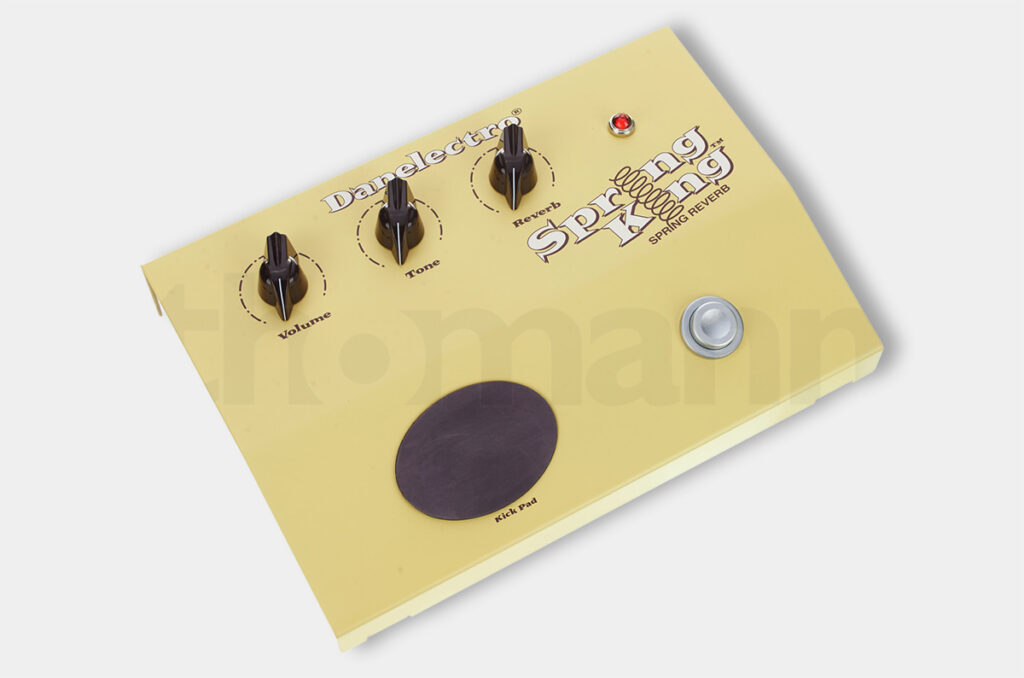
SPECIFICATIONS
Reverb types: 1
Parameters: Volume, Tone, Reverb
Inputs/Outputs: Mono input, mono output
Bypass: True Bypass
Analog/digital: Analog
LINK
Danelectro DSR-1 Spring King (129€)
ARGUMENTS IN FAVOR
- True analog spring reverb with very nice sound
- Better spring reverb sound than any other digital simulation
- Kick pad allows for thunder effect
NEGATIVE POINTS
- Very limited - can only create one type of reverb
- No option to change the decay time
Now we come to the first analog spring reverb on this list, the Danelectro DSR-1 Spring King. This reverb pedal has a real spring reverb built in, and that's why it sounds so amazingly good. It sounds like the classic amps that had spring reverb built in. You can even hear the rattling effect when you shake the pedal. The pedal even has a "kick pad" that you can hit to create this exact sound.
The Spring King has relatively few parameters, but this is simply because it is analog. For example, you can't adjust the decay time - it's determined by the physical length of the spring. There are only controls for Volume (determines how much guitar signal is sent into the spring reverb), Tone (a kind of low-pass filter), and Reverb (controls the volume of the spring reverb).
The Tone control is very useful for attenuating the high frequencies of the spring reverb. These high frequencies are often annoying with analog spring reverbs. The sound is vintage and reminiscent of surfer rock music from the 50s to the 70s.
The pedal is quite stable - but it has to be, because it needs to be "kicked" from time to time to create the rattling effect. It has only one mono input and one mono output, nothing more. The pedal sounds great with electric guitars, but also with synthesizers and keyboards. It adds an analog vintage flair to the otherwise synthetic sound of a synthesizer.
Strymon Nightsky Reverb
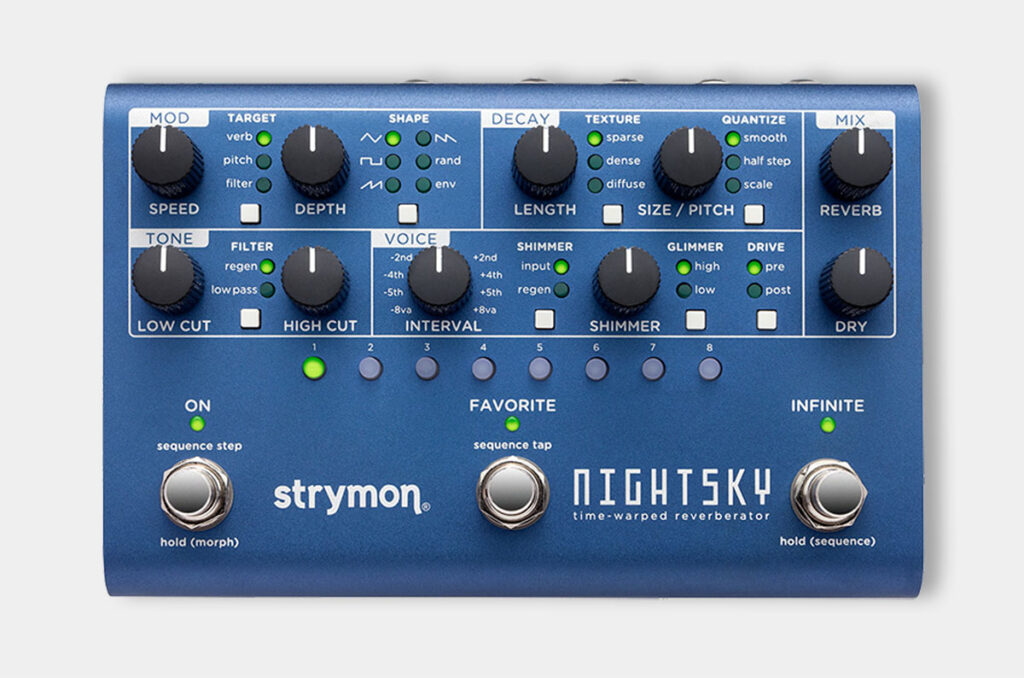
SPECIFICATIONS
Reverb types: 3
Parameters: Decay length, size/pitch, texture selection, low cut, high cut, filter type, voice interval, shimmer, reverb mix, dry mix, modulation speed, modulation depth
Inputs/Outputs: Stereo input, stereo output, expression pedal, mini-USB, MIDI in/out
Bypass: True bypass (buffered in trails mode)
Analog/digital: Digital
LINK
Strymon Nightsky Reverb (469€)
ARGUMENTS IN FAVOR
- Incomparable control of parameters
- Extremely good and realistic sound
- Experimental sounds possible
NEGATIVE POINTS
- Operation is somewhat complex at first and requires a certain familiarisation period
This pedal from Strymon combines the best features of the Big Sky, Strymon's bestseller, with very innovative and experimental features. The pedal has 3 different reverb modes: Sparse is a tap delay with reverb, Dense goes in the direction of plate reverb, and Diffuse is more of an ambient reverb.
With a total of 10 controls and numerous buttons and LEDs, the pedal looks a little intimidating, but upon closer inspection, it all makes sense. The controls are divided into 5 sections: Mod, Delay, Mix, Tone, and Voice.
The MOD section allows you to create complex modulations - you can modulate the reverb, pitch, or EQ. In the DECAY section, you can adjust the reverberation time and the size of the simulated room. The TONE section contains an EQ with two filters, a high pass and a low pass. This allows you to precisely adjust the tone color of the reverb.
In the VOICE section, you can turn on and control three different effects: SHIMMER (pitch-shifting the reverb), GLIMMER (emphasizing the upper harmonics), and DRIVE (distorting the reverb). This allows you to create some pretty crazy reverb effects that can sound anything but natural.
Then, of course, there is the MIX section, where you can precisely adjust the volume of the direct signal and the reverb. Finally, there is a sequencer that lets you set different intensities for size and pitch in 8 steps. Very innovative and maybe useful, but most people won't need it. There are enough settings without a sequencer.
Meris Mercury 7 Reverb Pedal
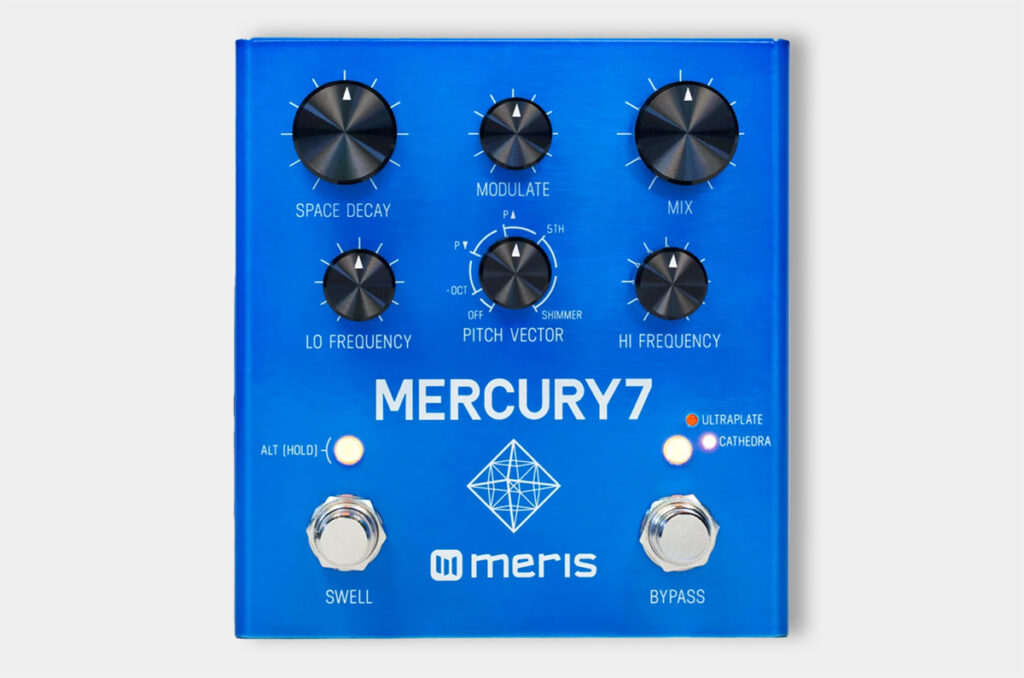
SPECIFICATIONS
Reverb types: 2
Parameters: Space Decay, Modulate, mix, Lo Frequency, High Frequency, Pitch Vector
Inputs/Outputs: Stereo input, stereo output, expression pedal
Bypass: True or buffered bypass
Analog/digital: Digital
LINK
Meris Mercury 7 Reverb Pedal (349€)
ARGUMENTS IN FAVOR
- Great giant Blade Runner-style reverbs
- Comprehensive and easy parameter control
NEGATIVE POINTS
- Not very versatile
Meris, a young company out of Los Angeles, has released a great device in the form of the Mercury 7 Reverb Pedal. Meris is backed by founders with impressive experience from their time at industry giants such as Line6 and Strymon, giving the company a solid foundation for innovation.
Inspired by the legendary reverbs from the iconic movie Bladerunner, the Mercury 7 offers a palette of sounds ranging from subtle and subdued to spacious and dynamic. It offers only two reverb modes, plate and cathedral, but you can do a lot with them.
Almost all reverb parameters are adjustable: Reverb Time, Predelay, Density, Dry/Wet Mix, and separate high and low frequency reverb times. Each individual control has a double assignment - the second function is activated by holding down the Alt key. The pedal also features an adjustable vibrato and the innovative Pitch Vector", which enables effects such as pitch drift and shimmer.
The pedal also offers the ability to morph the settings with an expression pedal, allowing for dynamic control of the sound in real time. The dual function of the Alt key controls may be a challenge at first-especially since no names are stored-but the relatively direct access to the parameters encourages intuitive and creative use of the effects unit.
What exactly does a reverb pedal do?
A reverb pedal is an effect device for musicians, especially guitarists, that artificially creates or recreates the spatial sound or reverberation of a signal. The purpose of a reverb pedal is to add a spatial dimension to the original sound, making the sound fuller, wider, and often more atmospheric. This effect can make music sound more alive and emotional than if it were played in a real room or environment.
This is especially important for studio recordings, as the microphone is almost always placed very close to the sound source. This makes the instrument sound extremely dry and rather unnatural to our ears, as we are also used to hearing instruments + reflections from walls, floor and ceiling and rarely hear the instrument so dry.
A reverb effect "brings the instrument into the room" and makes it sound more natural by simulating these reflections.
Where does the reverb pedal come in the effects chain?
There is no general answer to this question, as there is no "right" position. Typically, the reverb pedal will be at the very end of the chain; in the best case, the pedal should be connected directly to the guitar amp via an FX send loop. If the amp does not have an FX send loop, simply place the reverb pedal as the last pedal before the amp.
The problem, however, is that the reverb itself is also distorted when you turn up the distortion in the amp, and you don't usually want that. However, if the distortion is generated by a distortion pedal, then this is not a problem because this pedal comes before the reverb pedal.
If there was an effect behind the reverb, then that effect would also affect the reverb, and this is usually undesirable. Sometimes, however, this is the case - for example, a phaser after the reverb can produce very "spacey" sounds that sound anything but natural. If you want the reverb to sound natural, it should be at the very end of the chain.
What are the different types of reverb available?
There are several types of reverb, each of which simulates different acoustic environments and sound characteristics. This variety allows musicians and producers to select the desired spatial effect for each recording or live performance.
- Room Reverb: Simulates the acoustics of small to medium-sized rooms. Room reverbs can range from tight and intimate rooms to slightly larger and more open spaces. They are great for adding a sense of space to a signal without overpowering it.
- Hall Reverb: Imitates the reverberation of large rooms such as concert halls or cathedrals. Hall reverb tends to be longer and richer in reflections, creating a generous spatial depth and majestic atmosphere.
- Plate Reverb: Based on the technique of sending sound waves through a large, thin metal plate to create reverberation. Plate reverb delivers a smooth and dense sound that is especially popular for vocals and percussion in music production.
- Spring Reverb: Uses the resonance of metal springs to create reverb effects. Spring reverbs have a characteristic "boingy" sound often associated with guitar amps and surf music. They sound lively and metallic.
- Chamber Reverb: Simulates the sound of music played in a specially constructed chamber with reflective walls. Chamber reverbs create a warm and natural reverb that can be heard on many classical recordings.
- Cathedral Reverb: A special type of reverb designed to reproduce the powerful and impressive acoustic properties of cathedrals. Cathedral reverbs are long and spacious, ideal for creating a sacred or epic atmosphere.
- Reverse Reverb: Creates an effect where the reverb is heard before the actual attack or sound, as if it were played backwards. This unusual and psychedelic effect is often used for creative and experimental soundscapes.
- Gated Reverb: A reverb effect that ends abruptly before reaching its natural decay time, which is achieved with a noise gate. Gated reverb was popular on drums in the 1980s, especially the snare, to create a powerful but controlled room sound.
Why are reverb pedals so expensive?
Digital reverb pedals are some of the most expensive pedals out there because the algorithms required to simulate a room/reflection are very complex and require a lot of computing power. Especially if you want a realistic reverb - the pedal has to react quickly to all possible sound sources and "simulate" the sound reflections as they occur in real rooms.
Manufacturers therefore have to invest a lot in research in order to be able to develop such algorithms at all. And then they have to use very high-quality components so that the device can generate the reverb effect quickly and realistically. Of course, all of this drives up sales prices.
To give an example: The most expensive and best-known studio reverbs, such as the Lexicon 224, can cost several thousand dollars. The Lexicon 224, in particular, costs over $3,000 used today, while the popular Lexicon PCM96 costs just under $4,000 new.
Related articles:





